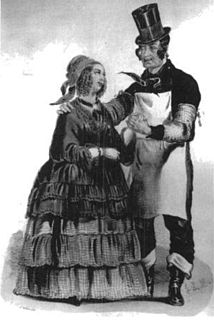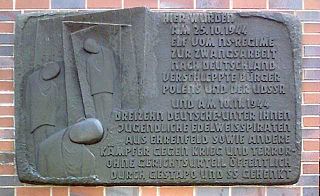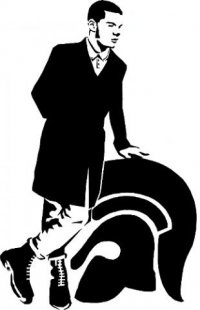 W
WB'hoy and g'hal were the prevailing slang words used to describe the young men and women of the rough-and-tumble working class culture of Lower Manhattan in the late 1840s and into the period of the American Civil War. They spoke a slang, with phrases such as "hi-hi", "lam him", and "cheese it".
 W
WBeatnik was a media stereotype prevalent throughout the late 1940s, 1950s to mid-1960s that displayed the more superficial aspects of the Beat Generation literary movement of the late 1940s and early to mid 1950s. Elements of the beatnik trope included pseudo-intellectualism, drug use, and a cartoonish depiction of real-life people along with the spiritual quest of Jack Kerouac's autobiographical fiction.
 W
WThe Edelweiss Pirates were a loosely organized group of youth in Nazi Germany. They emerged in western Germany out of the German Youth Movement of the late 1930s in response to the strict regimentation of the Hitler Youth. Similar in many ways to the Leipzig Meuten, they consisted of young people, mainly between the ages of 14 and 17, who had evaded the Hitler Youth by leaving school and were also young enough to avoid military conscription, which was only compulsory from the age of 17 onward. The roots and background of the Edelweiss Pirates movement were detailed in the 2004 film Edelweiss Pirates, directed by Niko von Glasow.
 W
WThe word geek is a slang term originally used to describe eccentric or non-mainstream people; in current use, the word typically connotes an expert or enthusiast obsessed with a hobby or intellectual pursuit, with a general pejorative meaning of a "peculiar person, especially one who is perceived to be overly intellectual, unfashionable, boring, or socially awkward".
 W
WIn the United States, gun culture encompasses the behaviors, attitudes, and beliefs about firearms and their usage by civilians. Gun ownership in the United States is the highest in the world, and constitutionally protected by the Second Amendment to the United States Constitution. Firearms are widely used in the United States for self-defense, hunting, and recreational uses, such as target shooting.
 W
WHipster or hepcat, as used in the 1940s, referred to aficionados of jazz, in particular bebop, which became popular in the early 1940s. The hipster adopted the lifestyle of the jazz musician, including some or all of the following: dress, slang, use of marijuana and other drugs, relaxed attitude, sarcastic humble or, self-imposed poverty, and relaxed sexual mores.
 W
WInternational Times is the name of various underground newspapers, with the original title founded in London in 1966 and running until October 1973. Editors included Hoppy, David Mairowitz, Roger Hutchinson, Peter Stansill, Barry Miles, Jim Haynes and playwright Tom McGrath. Jack Moore, avant-garde writer William Levy and Mick Farren, singer of The Deviants, also edited at various periods.
 W
WThe Mojave phone booth was a lone telephone booth in what is now the Mojave National Preserve in California. It attracted online attention in 1997 for its unusual location - it was located at the intersection of two dirt roads in a remote part of the Mojave Desert, 12 miles (19 km) from the nearest paved road and miles from any buildings.
 W
WPachucas were Mexican American women who wore zoot suits during World War II, also known as “cholitas”, “slick chicks”, and “lady zoot suiters”. The suit was a symbol of rebellion due to the rationing of cloth for the war effort. Wearing the longer and loose-fitting jackets and pants was therefore seen as being unpatriotic. The zoot suit was the most salient identifying feature of “pachuquismo”, a Mexican American youth subculture. This subculture emerged during a time of increased racism and the fight for Mexican American rights and equality within American society. Both men and women wore the fingertip coats, but for women it became more than just a style. Pachuca gangs, like the Black Widows and Slick Chicks, with their black drape jackets, tight skirts, fishnet stockings and heavily emphasized make-up, were ridiculed in the press. This was not just the case for pachuca women in gangs, but pachuca women in general. Participation in the movement was a way to openly challenge conventional notions of feminine beauty and sexuality, especially in Mexican culture.
 W
WPachucos are male members of a counterculture associated with zoot suit fashion, jazz and swing music, a distinct dialect known as caló, and self-empowerment in rejecting assimilation into Anglo-American society that emerged in El Paso in the late 1930s. The pachuco counterculture flourished among Chicano boys and men in the 1940s as a symbol of rebellion, especially in Los Angeles. It spread to women who became known as pachucas and were perceived as unruly, masculine, and un-American. Some pachucos adopted strong attitudes of social defiance, engaging in la vida loca seen as deviant by white society, such as marijuana smoking, gang activity, and a turbulent night life. Although concentrated among a relatively small group of Mexican Americans, the pachuco counterculture became iconic among Chicanos and a predecessor for the cholo subculture which emerged among Chicano youth in the 1980s.
 W
WThe history of the punk subculture involves the history of punk rock, the history of various punk ideologies, punk fashion, punk visual art, punk literature, dance, and punk film. Since emerging in the United States, the United Kingdom and Australia in the mid-1970s, the punk subculture has spread around the globe and evolved into a number of different forms. The history of punk plays an important part in the history of subcultures in the 20th century.
 W
WThe Red Dog Saloon is a bar and live music venue located in the isolated, old-time mining town of Virginia City, Nevada which played an important role in the history of the psychedelic music scene.
 W
WThe suedehead subculture was an early-1970s offshoot of skinhead subculture in the United Kingdom and Ireland. Although sharing similarities to 1960s skinheads, suedeheads grew their hair longer and dressed more formally. Although often working class like skinheads, some had white collar jobs. A female suedehead was a sort.
 W
WTrojan skinheads are individuals who identify with the original British skinhead subculture of the middle 1960s, when ska, rocksteady, reggae, and soul music were popular, and there was a heavy emphasis on mod-influenced clothing styles. Named after the record label Trojan Records, these skinheads identify with the subculture's Jamaican rude boy and British working class roots.
 W
WThe British counter-culture or underground scene developed during the mid 1960s, and was linked to the hippie and subculture of the United States. Its primary focus was around Ladbroke Grove and Notting Hill in London. It generated its own magazines and newspapers, bands, clubs and alternative lifestyle, associated with cannabis and LSD use and a strong socio-political revolutionary agenda to create an alternative society.
 W
WWandervogel is the name adopted by a popular movement of German youth groups from 1896 to 1933, who protested against industrialization by going to hike in the country and commune with nature in the woods. Drawing influence from medieval wandering scholars, their ethos was to revive old Teutonic values, with a strong emphasis on German nationalism. According to historians, a major contribution of the Wandervögel was the revival of folk songs in wider German society.
 W
WThe zazous were a subculture in France during World War II. They were young people expressing their individuality by wearing big or garish clothing and dancing wildly to swing jazz and bebop. Men wore large striped lumber jackets, while women wore short skirts, striped stockings and heavy shoes, and often carried umbrellas.